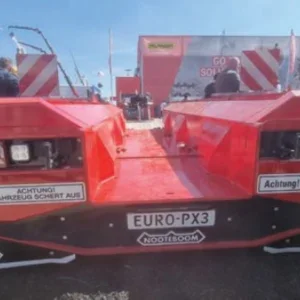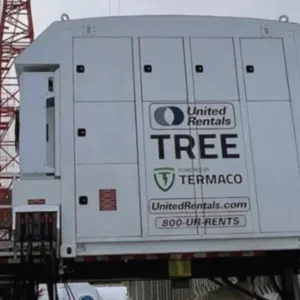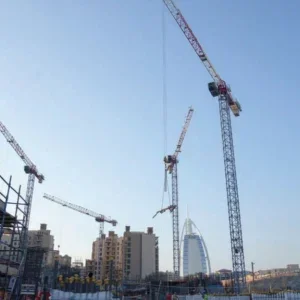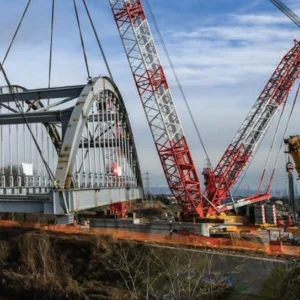The big news in 1998 for the UK crane industry was the closure of Grove’s Sunderland manufacturing plant at the end of the year, leaving the country without an indigenous mobile crane manufacturer. But it is not all doom and gloom in the UK crane industry.
The UK market for mobile cranes is habitually Europe’s second biggest, behind Germany, accounting for 16% of European sales in 1997, which equates to about 250 to 300 units. The all-terrain/truck crane ratio is roughly 2:1. Though most consider 1998 to have been a good year, new sales appear to have been down slightly, though this is, in part, explained by the unusually high number of nearly new machines sold. Liebherr sent about 50 or 60 nearly new or reconditioned cranes to the UK in 1998 on top of a similar number of new cranes, to give it approaching a third of the new AT market. This year Liebherr expects its sales of used cranes to be well down on last year’s number as the source, eastern Germany, is drying up, but sales of new cranes are expected to hold steady.
Kato Cranes (UK), distributor of Kato and Marchetti cranes, had its best year since 1990 last year, capturing about a third of the UK mobile crane market (including truck cranes and ATs) by selling 94 new cranes in 1998, according to sales director Paul Rosevere.
Rosevere had predicted that the UK market would slow down in 1999, but has been pleasantly surprised by the lack of a downturn in the early months of the year. “The year has started well,” he says.
Kato and Tadano dominate the truck crane market outside North America, but in the UK Grove Crane has been trying to make a challenge with its 25t TMS 3025. “It has been well received,” says Grove UK sales director Bill Green.
“It has sold mainly into Ireland, where they like the long boom and the commercial chassis,” he says.
Green reckons to have sold 71 new machines in 1998, of which 12 were for export, compared with 96 new cranes sold in 1997. The fall is explained by the closure of the Sunderland plant, removing the last choice for the sentimentalists who preferred to buy British. Major recent deliveries include 10 GMK 3050s (50t AT) to Baldwins. Generally, ATs account for two thirds of Green’s sales.
Mannesmann Dematic also enjoyed 1998 in the UK and expects 1999 to continue in the same vein. Sales include 20 units of the AC 80 (with six of these going to the rental company Ainscough). The AC 80 can carry 18t of counterweight and so can do some of the jobs the higher rated LTM 1090 cannot, according to Mannesmann Dematic’s Mark Evans.
As for the crane users, most also see 1999 as a similar year to 1998: no growth, but steady business.
Levels of optimism vary considerably. Alex Lowe of national operator Hewden Crane Hire says that although the year started slowly, he is “optimistic about this year”.
In the southeast, Terranova managing director Alex Lowe says: “We are reasonably busy. I think the market is holding.” On the south coast Geoffrey Marsh of Marsh Plant says: “We are satisfied but apprehensive. No downturn is visible, but it could be severe when it comes.” Last year Marsh spent £3m ($5m) on new cranes and the acquisition of Adberweld in Yeovil, so does not plan to spend much this year.
Martin Ainscough, managing director of Ainscough Crane Hire, whose homeland is northwest England but has rapidly gained a national presence, is perhaps the most pessimistic. “I think the picture is rather bleak at the moment. It slowed down in the last quarter of 1998 and we have had a slow start to 1999. Rates are absolutely diabolical.” Ainscough had some success making a price increase stick in the mid part of 1998 only to find them fall again due to “totally suicidal pricing by some of our competitors. In spite of this, he adds: “I am quite confident the market will start to pick up again later in the year.” Ainscough maintains its aggressive approach towards growth, which has seen it double its turnover from £15m to £30m ($48m) in the last five years, and its fleet double to about 240 cranes.
Facing adversity head on, Ainscough acquired four Peterhead depots from the receivers in February (see News) to add to the depot in Inverkeithing, Scotland that it had bought from Peterhead a few weeks previously.
It has recruited a new managing director for its engineering services division, for which expansion is planned, and set up and access equipment rental division which is going well, Ainscough says. A planned move into tower cranes has now been abandoned, however.
Initial GWS managing director Andrew Makepeace says that a few ‘one off’ projects, such as oil industry spending by BP at Grangemouth and Hull, reconstruction in Birmingham city centre and building projects funded by the national lottery to mark the millennium are keeping his cranes busy.
“In general, it’s not too bad at all,” he says. And then there is the prospect of work on the high speed rail link project from the channel tunnel to London which should start this year.
Makepeace echoes the common refrain: “Rates are not what they should be.” However, he achieved the target set by his parent company’s board last year of hitting a 20% increase in profits, through a simple combination of utilisation of assets and rates.
New depots were opened in Hull and Edinburgh last month, in Northampton last November, and more locations are being sought. Acquisitions are always a possibility but vendors generally believe their businesses are worth more than the book value of their assets.
“At any given time we have always got one or two acquisitions that we are considering, but generally people have an unrealistic view on the value of goodwill in their companies,” says Makepeace.
Recent purchases by Initial GWS include an order placed in October for 20 Liebherr ATs in the 40t to 160t range and for five Kato CR-250 city cranes which arrived last month. Four used Tadano Fauns were bought towards the end of 1998 in addition to about 40-odd delivered during the course of last year.
Makepeace, though, still has no regrets about selling his heavy cranes division to Sarens in 1997 and has no intention of buying big mobiles of capacities of 500t or above. He believes that the UK market is already saturated and there is no money to be made on them.
Liebherr Great Britain director David Milne does not entirely agree. He has sold five LTM 1800s in the UK to date. Rated by Liebherr at a standard 800t, most owners have superlift attachments enabling them to market theirs as 1,000t capacity. Only four of these are still at work in the UK as Hewden Crane Hire has since sold the one it bought in favour of the first Mannesmann Dematic AC 650, citing transportability benefits as the primary motive, as this crane lays claim to being the largest that can travel complete with boom and rigging.
Hewden takes delivery of its AC 650 this month. Martin Ainscough says that he is also considering buying “something between 400t and 1,000t” – which sounds a lot like an AC 650.
With Hewden’s former LTM 1800 sold outside of the country, those who own the UK’s remaining four models (though they market them under a variety of personalised designations) are Baldwins, which has two, Ainscough and Aberdeen-based Ashley, which took delivery at the start of the year.
“I think the UK market can sustain one more,” is Milne’s opinion.
Ashley, by no means a major national player, with a fleet of just 20 cranes, may seem an unlikely purchaser of such an expensive piece of equipment, but it appears to be a company on the up. It is using its LTM 1800 without a luffer for lifting work in dockside environments in support of the offshore industry. Actually, the new crane lay idle in the yard for the first six weeks, but the order book is now beginning to fill, the company says.
Martin Ainscough also admits that his LTM 1800 (The Millennium Lifter) “has been a little quiet, but is starting to move now. We have got a lot of contracts in the pipeline.” Ashley’s crane coordinator Ross McKay says he plans to buy a 400t LTM 1400 “very soon” and is in the market for the 500t machine that Liebherr is expected to bring to market this year. “Although there’s a recession, we are very buoyant,” he says.
Liebherr has already sold 12 LTM 1400s in the UK. Milne says the new 90 tonner is also proving popular in the UK, having sold about 20 there to date. It is a market that Terex’s UK distributor, European Cranes, is keen to get into. Terex PPM unveiled the prototype of a new 90t model at an open house at its factory in France last year, with a 53m boom (Terex PPM previews… Nov98, p3).
European Cranes’ director Alan Charlesworth reports much interest in this machine but it will not be ready for delivery until later in the year.
Meanwhile he relies on steady sales of the 30t and 35t two-axle PPM cranes to the smaller and medium sized end-users. He says that he shifted 30 ATs last year and he expects to sell about the same number this year. However, he is facing competition from the increasingly popular, though more pricey, compact city cranes of Kato and Mannesmann Dematic, the CR-250 and the AC 25.
The CR-250 came to market in the UK about six months or more after the AC 25, but Kato UK reckons its model is now outselling the Demag, having sold 40 since its October 1997 launch. Mannesmann Dematic claims that it has sold “about 50” of the AC 25 in the UK and has cut the price of the machine to add spice to the contest.
As well as the aforementioned Initial GWS bulk order, other users of the CR-250 include Baldwins, which has eight in its fleet.
Last year saw the launch of the 40t version of the Demag city crane, the AC 40-1. Four have been delivered in the UK so far; they have gone to Capel Developments, Terranova, James Jack and Hewden Crane Hire, which has a further eight on order.
Scotland’s James Jack is another smaller company in growth mode. Its fleet has doubled in the past couple of years to 30 units, with all machines bought new and nothing in the fleet over three years old, according to director Cameron Coutts. Recent arrivals include two LTM 1090s, and an LTM 1050, as well as the AC40-1.
James Jack also has 40t, 60t, and 80t cranes on order from Liebherr, says Coutts, and a 400t LTM 1400 is under consideration.
Growth has been funded by projects in the oil sector. A depot in Grangemouth was opened last year to be near the BP work. The company also has new purpose-built premises in Aberdeen and a depot in northeast England may not be far behind.
Though the AC 40-1 has been bought, it seems that what James Jack really wanted was a Kato version, only it does not exist. The company has two CR-250s and loves them. “They’re excellent, the Kato cranes, very reliable,” says director Cameron Coutts. “We will get a 40t Kato city crane, without a doubt.” Sorry Cameron, but a quick call back to Paul Rosevere reveals that Kato in Japan has no firm plans for such a crane, even though Rosevere has already received three orders for it. Once again, Mannesmann Dematic is able to steal a lead over the Japanese in Europe, for it was only after the AC 25 starting flying out of the showrooms that Kato woke up and sent the CR-250 over to Europe.
A firm supporter of the Mannesmann Dematic product is Hewden Crane Hire. As well as the AC 650 and the collection of AC 40-1s, it has ordered six AC 25s to add to the six that it already operates, two AC 80s and five AC 50Es. Director Alex Lowe is enthusiastic about the AC 25s. “They fit into the fleet like they’ve always been there,” he says.
Perhaps the best barometer available for the state of the UK crane hire industry is Baldwins’ share price. The company floated on the London stock exchange last July. Initial GWS and Hewden Crane Hire are also publicly quoted, but are part of larger, more diversified organisations. No doubt Baldwins plans diversification too, but for now it is just cranes. And what has happened to the share price? It rose 30% in the first six months.






